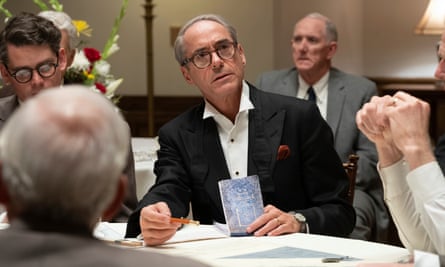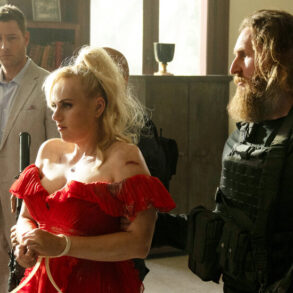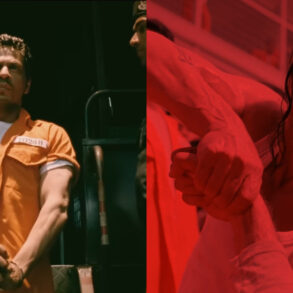Early on in the new Mission Impossible film, a group of sharp-suited intelligence agents gather to discuss a grave new threat to national security. Their nemesis is apparently a “godless, stateless enemy” which is “everywhere and nowhere”, “a self-aware, self-learning, truth-eating digital parasite”. Your heart sinks slightly as you realise that Tom Cruise’s latest adversary is in fact a sentient computer code. An action movie without a real villain? Hans Gruber would be spinning in his grave.
Seasoned Cruise fans, though, will know not to panic. Last summer, Top Gun: Maverick pulled off the same trick, ticking every crowdpleasing action-movie convention except one: it had no bad guy. Instead – as with the original – “the enemy” was a carefully unspecified nation state, its only human representatives a handful of faceless fighter pilots who pop up in our heroes’ crosshairs at the end.
There’s more to come. This autumn’s bombastic dystopian drama The Creator tasks John David Washington with saving humanity from a similarly intangible menace: a malevolent AI. And after that, Ridley’s Scott’s Napoleon promises to be a bloody battlefield epic in the vain of Braveheart and Gladiator, except this one examines its warlord not through his sworn enemies but via his explosive romance with Vanessa Kirby’s Empress Josephine.

Hollywood’s sudden hostility to hostility is even playing out in cinemas now. One of the few traits shared by both Barbie and Oppenheimer is the refusal to provide their tortured title characters with a serious antagonist. Oppenheimer has a faint stab at it late on, offering up Robert Downey Jr in the final act. But his middling bureaucrat isn’t a real villain. As for Ryan Gosling’s Ken, who threatens to steal our sympathies altogether, he’s no sort of villain at all: more Dr Evil than proper evil.
Perhaps those films are too thoughtful to draft in a truly two-dimensional adversary. And yet the Fast and the Furious franchise – the modern standard-bearer in brainless popcorn fodder – is just as guilty here. It has made a habit of introducing each new baddie ready-made to be co-opted into our heroes’ ever-expanding gang of lovable rogues, mortal differences set aside over a cold Corona in the final reel.
A similar goodie-as-baddie ploy was also used by the runaway success story of last year: Everything Everywhere All at Once, a kung-fu epic that pitted its heroine against an otherworldly bandit who also happened to be her own sulky daughter. Spoiler alert: it was all settled with a big hug.
Have audiences finally outgrown the scenery-chewing supervillain? Thankfully not: the character is alive and well in the Marvel and DC films, which serve up a blandly nefarious opponent with every edition. Likewise the more fantastical mega-budget fare: Avatar, Dune, Dungeons & Dragons. Nor are Bond villains going anywhere in a hurry.
But generally speaking, blockbusters set in the real world seem to be taking a lot more care over who, if anyone, they pit their heroes against. Whereas four decades ago Rocky Balboa was sent out to fight Ivan Drago – a straightforward stand-in for dead-eyed Soviet power – these days his protege Adonis Creed finds himself in the ring with his old school friend, both men forced to confront their own repressed emotions in the process. All very grown up, but where have all the paper-thin hate figures gone?




Presumably part of it is down to a diminishing appetite for the flatly racist caricatures that occupied the attentions of Stallone, Seagal and co for so long. Part of it too is down to simple economics: with mid-budget films having been all but squeezed out of existence, and the threshold for box-office success now absurdly high, global takings have become pivotal to whether a movie sinks or swims. In other words, Hollywood isn’t just courting America any more.
So it’s yippee ki-yay not just for Gruber’s brand of erudite European mastermind, but also the unhinged Arab terrorist (True Lies, London Has Fallen), the icy Russian psychopath (Air Force One, GoldenEye) and the crazed Latino gangbanger (Falling Down, End of Watch). It also explains why the only explicitly nationalised baddies to pop up of late have been Indiana Jones’s wartime Nazis – the only group left that no one minds discriminating against.
after newsletter promotion
But if the urge to appeal to everyone has helped flush out xenophobic cliches, it has also deprived the screen villain of a key part of their armoury: the capacity for ruthless violence. Back in the day, it was standard practice for the bad guy to set out his stall with the theatrical murder of a civilian, before getting to the real sadism a bit later on: for Heath Ledger’s Joker this meant impaling a rival henchman with a pencil; Die Hard 2’s racketeer preferred to plough a jumbo jet full of passengers into the ground.
But that sort of behaviour tends to rule out a family-friendly certification – and what use is a bad guy who can’t mutilate an innocent victim? “Nothing wrong with shooting as long as the right people get shot,” said Harry Callaghan in 1973. Fifty years later Hollywood isn’t so sure. Today’s blockbusters tend to render violence like they do sex: sterilised, sanitised and strategically discreet.
The upshot is that the maniacal villain with his army of disposable goons, for so long a staple of the Hollywood diet, has become an endangered species in the multiplex. These days he lives on largely within the John Wick films, which pretty much stand alone in their keen embrace of good old-fashioned cartoonish ultraviolence.
The rest of today’s villains are largely consigned to the make-believe realms of the superhero and fantasy genres, where their conduct is defanged and palatable, while films set in the real world have to make do with baddies barely worthy of the title – or, increasingly, no baddie at all. And what good is that to anyone?
This post was originally published on this site be sure to check out more of their content.








